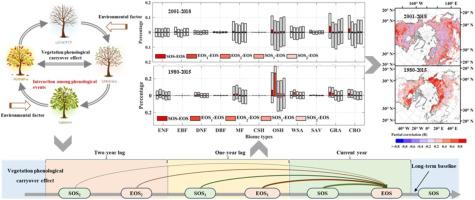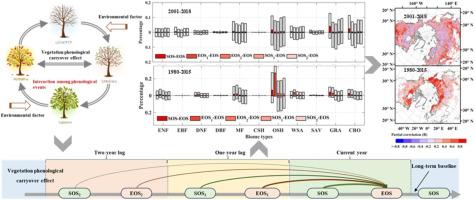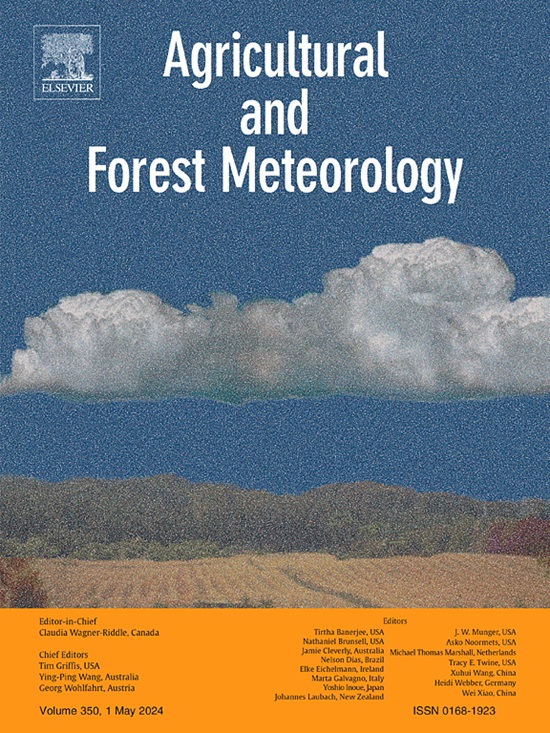气候变化下植被物候延续效应对植物秋季物候的影响
IF 5.6
1区 农林科学
Q1 AGRONOMY
引用次数: 0
摘要
植被物候延续效应是指以前的物候事件对当前或以后物候事件的影响。这些影响可以调节秋季物候对气候变化的反应,但人们对这种影响的程度和持续时间仍然知之甚少。因此,我们采用了北半球(> 30°N)从1982年到2018年的多个遥感数据集和部分相关性,来研究随时间推移的携带效应和环境因素对生长季末期(EOS)的影响。变量在预测得分中的重要性被用来量化它们的相对重要性。结果表明,1982-2015 年间,上一年的 EOS 对 40.02% 的研究区域的 EOS 有显著的积极影响,这些区域主要位于北纬 50°以北地区。相比之下,在 2001-2018 年期间,生长季节的开始(SOS)是 EOS 的主要影响因素,主要集中在 40°N-50°N 和俄罗斯北部地区。结转效应持续到下一年,但其强度和积极影响在下一年有很大不同。同时,气候因子与 EOS 之间的平均相关系数从 0.20 上升到 0.22。值得注意的是,霜冻日频率的相关系数从 0.15 显著增加到 0.36(P <0.05),其影响范围从占研究区域的 10.29% 扩大到 11.85%。与气候因素相比,物候转移效应是各植被类型 EOS 的主要驱动因素,在 1982-2015 年和 2001-2018 年期间分别占总像素的 72.8 % 和 44.23 %。我们的研究揭示了一连串超出最初发生范围的生态后果,并强调了植物生命周期中各生长阶段之间的相互联系,为了解植物群落的适应性和脆弱性提供了宝贵的见解。本文章由计算机程序翻译,如有差异,请以英文原文为准。


Influence of vegetation phenological carryover effects on plant autumn phenology under climate change
Vegetation phenological carryover effects refer to the influence of previous phenological events on the current or subsequent ones. These effects can modulate the responses of autumn phenology to climate change, but the magnitude and duration of this effect remain poorly understood. Therefore, we employed multiple remote sensing datasets from 1982 to 2018 in the Northern Hemisphere (> 30°N) and partial correlation to investigate the influence of the carryover effect and environmental factors on the end of the growing season (EOS) over time. The importance of the variables in the projection score was used to quantify their relative importance. Our results showed that the previous year's EOS had a robust positive impact on the EOS for 40.02 % of the study area during 1982–2015, which was mainly located in the northern 50°N region. In contrast, the start of the growing season (SOS) was the main contributor to the EOS during 2001–2018, mainly at 40°N-50°N and in northern Russia. The carryover effect persisted into the subsequent year, but its strength and positive impacts varied dramatically in the next year. Concurrently, the mean correlation coefficient between climate factors and EOS rose from 0.20 to 0.22. Notably, the correlation coefficient for frost day frequency increased significantly (P < 0.05) from 0.15 to 0.36, with its influence area expanding from 10.29 % to 11.85 % of the study area. Compared with climate factors, the phenological carryover effect was the dominant driver of the EOS for each vegetation type, accounting for 72.8 % and 44.23 % of the total pixels during 1982–2015 and 2001–2018, respectively. Our study reveals a cascade of ecological consequences that extend beyond the initial occurrence and emphasizes the interconnectedness of growth stages in the plant life cycle, providing valuable insights into the adaptability and vulnerability of plant communities.
求助全文
通过发布文献求助,成功后即可免费获取论文全文。
去求助
来源期刊
CiteScore
10.30
自引率
9.70%
发文量
415
审稿时长
69 days
期刊介绍:
Agricultural and Forest Meteorology is an international journal for the publication of original articles and reviews on the inter-relationship between meteorology, agriculture, forestry, and natural ecosystems. Emphasis is on basic and applied scientific research relevant to practical problems in the field of plant and soil sciences, ecology and biogeochemistry as affected by weather as well as climate variability and change. Theoretical models should be tested against experimental data. Articles must appeal to an international audience. Special issues devoted to single topics are also published.
Typical topics include canopy micrometeorology (e.g. canopy radiation transfer, turbulence near the ground, evapotranspiration, energy balance, fluxes of trace gases), micrometeorological instrumentation (e.g., sensors for trace gases, flux measurement instruments, radiation measurement techniques), aerobiology (e.g. the dispersion of pollen, spores, insects and pesticides), biometeorology (e.g. the effect of weather and climate on plant distribution, crop yield, water-use efficiency, and plant phenology), forest-fire/weather interactions, and feedbacks from vegetation to weather and the climate system.

 求助内容:
求助内容: 应助结果提醒方式:
应助结果提醒方式:


